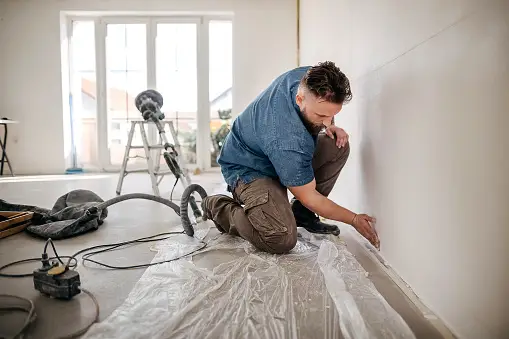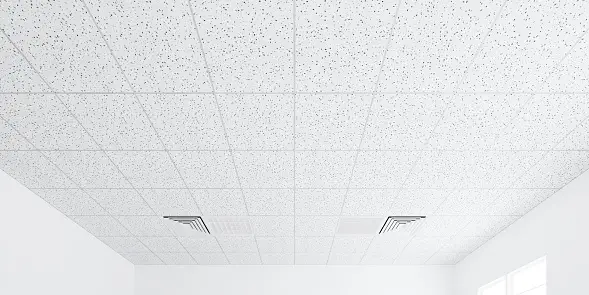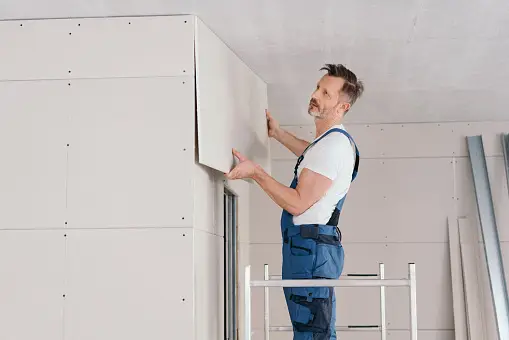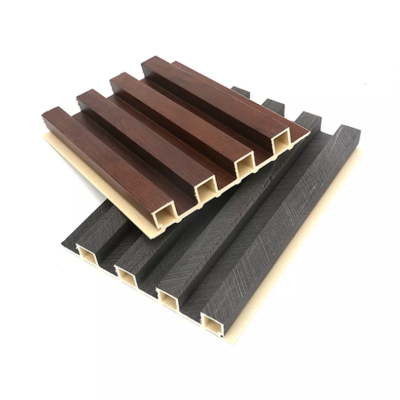Drywall, also called wallboard, is any large rigid sheets of finishing material used to face the interior walls of homes and other buildings. Drywall construction uses no mortar or plaster.
What is Drywall?
Plywood, wood pulp, asbestos-cement board, and gypsum make drywall. Wood fiber and pulp boards are compressed with adhesives and have wood grain and other surface effects. They also have high sound-suppressing and thermal-insulating capacities. Wetted Portland cement and asbestos fiber are pressed into asbestos-cement boards. Some asbestos-cement boards are strengthened with organic fibers and treated with curing agents, water-repellent admixtures, and other substances to improve performance and machining. Thin asbestos-cement sheets are backed with plywood or insulating board for impact resistance.
7 Types of Dry Wall
Gypsum tile ceiling or panel drywall is popular. Gypsum, a calcium-hydrous sulfate mineral, is crystalline. The Gypsum board has a rock core between two special paper layers. Glass fibers are mixed with gypsum to make fire-resistant panels for many construction projects. Aluminum-backed panels insulate. Gypsum drywall comes unfinished or with various vinyl and other finishes in permanent colors and textures without additional treatment to finish interior wall surfaces.
1) Normal drywall or whiteboard (Regular)
Use for: room walls and ceilings
The most common type of drywall in homes, regular drywall (also called whiteboard), is white on one side and brown on the other and suitable for most rooms. It’s made of gypsum but not mold- and mildew-resistant.
Regular drywall is used in bedrooms, living rooms, hallways, and some basements but not in bathrooms or kitchens. This drywall is the cheapest and comes in 3/8-inch to 1-inch thicknesses. Most homes have 1/2-inch drywall. $12–$18 per 4-by-8-foot panel.

2) Greenboard Drywall
Use for: Kitchens and bathrooms.
Green board drywall, also called moisture-resistant drywall, is water-resistant due to its green coating. The green board is wax-coated drywall. It is used as a tile backer in limited wet areas like bathrooms, kitchens, laundry rooms, basements, and utility rooms.
This drywall isn’t waterproof, but it prevents moisture from building up in humid rooms (don’t use it in direct contact with water). Green board outlasts drywall due to its wax coating. It costs $14–$18 for 4-by-8-foot panels.
3) Blueboard drywall
Use for: Plaster backing
Plaster baseboard, or blue board drywall, supports veneer plastering. Blue board’s surface paper absorbs gypsum to look like plaster. Veneer plastering is simpler than mudding and taping, and blue board drywall cannot be painted.
This drywall is water- and mold-resistant, reducing noise in bathrooms and other moist areas. Like a green board, a blue board costs $12 to $15 for 4-by-8-foot panels and is used for aesthetics.
4) Paper-free Drywall
Use for: Waterproof durability
Fiberglass, instead of paper, protects paperless drywall from rot and mold, and mildew. Despite costing $25 to $35 for a 4-by-8-foot panel, it’s becoming more popular as a drywall alternative.
Paperless drywall is tougher than regular drywall, but some construction pros find it easier to cut. The joint compound helps installers smooth this board’s slight textures.
5) Purple Drywall
Use for: Mold and mildew resistance in damp areas
Purple drywall has the same benefits as green but is mold and mildew-resistant. This drywall has a 100% recycled paper-coated gypsum interior for better water resistance than green drywall.
It is ideal for moisture and mold resistance in all wall and ceiling applications. Water-resistant drywall should be purple. Depending on the type of purple drywall, a 4-by-8-foot panel costs $15 to $60 (high-impact and sound-breaking options are available).
6) Type X Drywall
Use for: Fire resistance
Type X fire-resistant drywall contains fiberglass. Multiple layers of this drywall slow fire progression. Its thickness improves soundproofing.
Gypsum board must have a one-hour fire-resistance rating for the 5/8-inch board or a 3/4-hour rating for the 1/2-inch board in a single layer, nailed on each face of load-bearing wood framing members, to be designated “Type X.”
When required by building codes, garages, and apartment buildings use this harder-to-cut drywall. Fire-resistant drywall costs $20–$20 per 4-by-8-foot panel.
7) Soundproof Drywall
Use for: Room soundproofing
Soundproof drywall is laminated with wood fibers, gypsum, and polymers to increase STC.
This dense drywall may be harder to cut than other popular options. Its soundproofing properties make it useful in noisy areas or quiet rooms.

Picking Drywall
Consider the room and use it when choosing drywall for your home. Most living rooms and bedrooms can use regular drywall, but bathrooms and kitchens need moisture-resistant options like green boards. Water-logged bathrooms may need purple drywall.
Type X drywall is required in garages and shared walls in apartments, condos, and townhouses. This prevents fires.
If you still need clarification, consult a contractor. Local drywallers can help you choose the best option for your home.

